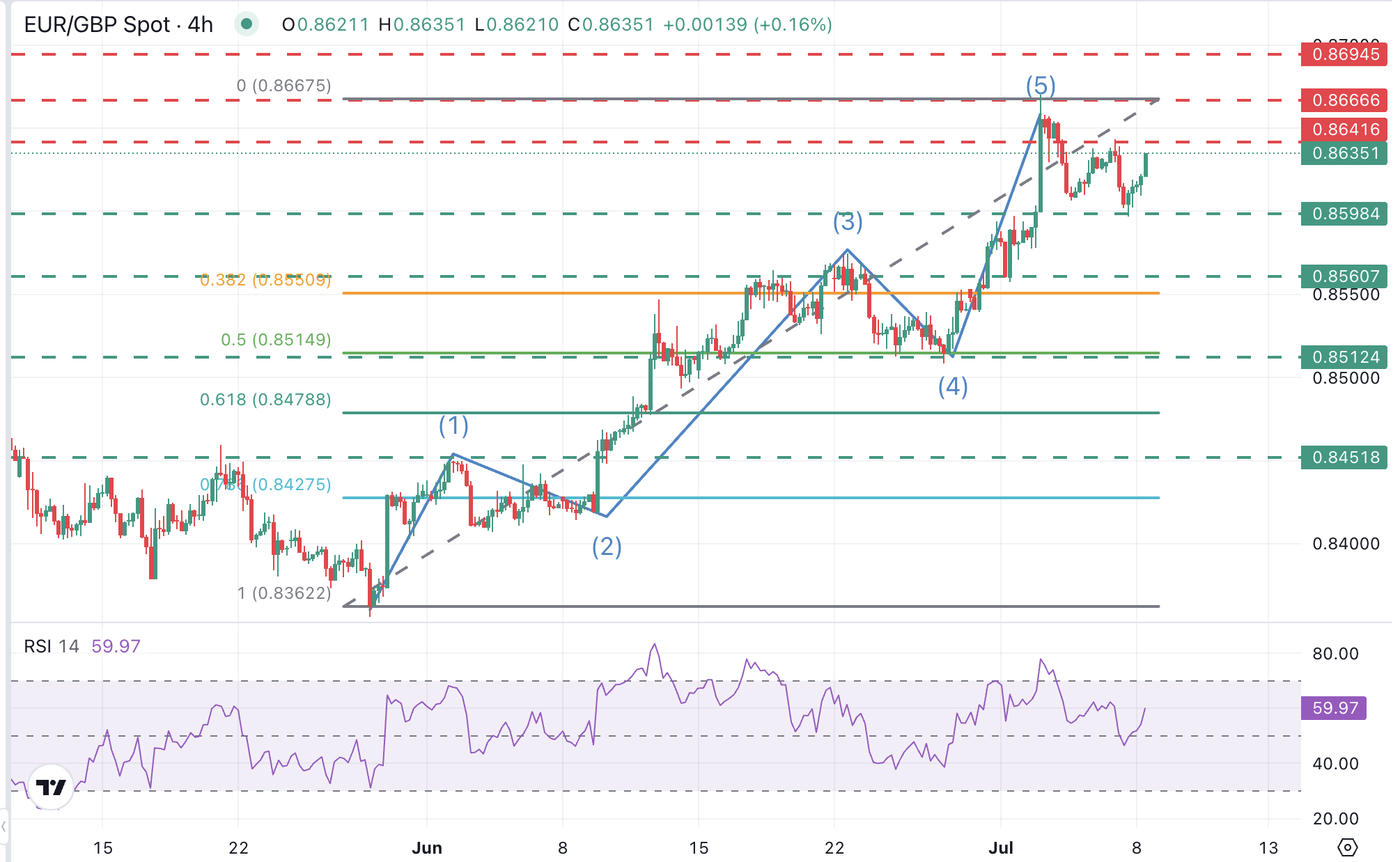EUR/GBP Price Forecast: In a corrective pullback, supported by 0.8600
- Hopes of a trade deal between the US and the Eurozone are keeping the Euro buoyed on Tuesday.
- The technical picture shows a mixed to negative trend from last week's highs.
- Resistances at 0.8640 and 0.8665 are likely to hold upside attempts today.
The Eurozone has skipped the first round of tariff letters by the US Administration, and that is good news for the Euro. The trade talks with the US advance, and apparently on good terms, which feeds hopes that the EU might be able to avoid even the 10% baseline tariff.
This news has contributed to lifting the Euro on Tuesday and reversing Monday’s decline as mixed trade data from Germany and France has failed to improve confidence in the Common Currency. From a broader perspective, the 4-hour chart highlights a mixed to bearish corrective trend from last week’s high, at 0.8670.
Technical Analysis: EUR/GBP is giving signs of topping

The technical picture in the four-hour chart is mixed. The RSI is back above 50, but price action is showing a descending trend from the July 2 highs. Elliott Wave analysis suggests that the pair has completed a 5-Wave bullish cycle and is now in an A-B-C correction.
Immediate support is at 0.8600 (July 7 low) ahead of the 0.8550 - 0.8560, where the July 1 low meets the 38.2% Fibonacci retracement of the June-July rally, and a significant technical floor for a bearish correction.
On the upside, July 4 and 7 highs at the 0.8640 area are closing the path towards the July 2 high, at 0.8665. A confirmation above here cancels this view and shifts the focus to the year-to-date high, at 0.8740.
Euro FAQs
The Euro is the currency for the 19 European Union countries that belong to the Eurozone. It is the second most heavily traded currency in the world behind the US Dollar. In 2022, it accounted for 31% of all foreign exchange transactions, with an average daily turnover of over $2.2 trillion a day. EUR/USD is the most heavily traded currency pair in the world, accounting for an estimated 30% off all transactions, followed by EUR/JPY (4%), EUR/GBP (3%) and EUR/AUD (2%).
The European Central Bank (ECB) in Frankfurt, Germany, is the reserve bank for the Eurozone. The ECB sets interest rates and manages monetary policy. The ECB’s primary mandate is to maintain price stability, which means either controlling inflation or stimulating growth. Its primary tool is the raising or lowering of interest rates. Relatively high interest rates – or the expectation of higher rates – will usually benefit the Euro and vice versa. The ECB Governing Council makes monetary policy decisions at meetings held eight times a year. Decisions are made by heads of the Eurozone national banks and six permanent members, including the President of the ECB, Christine Lagarde.
Eurozone inflation data, measured by the Harmonized Index of Consumer Prices (HICP), is an important econometric for the Euro. If inflation rises more than expected, especially if above the ECB’s 2% target, it obliges the ECB to raise interest rates to bring it back under control. Relatively high interest rates compared to its counterparts will usually benefit the Euro, as it makes the region more attractive as a place for global investors to park their money.
Data releases gauge the health of the economy and can impact on the Euro. Indicators such as GDP, Manufacturing and Services PMIs, employment, and consumer sentiment surveys can all influence the direction of the single currency. A strong economy is good for the Euro. Not only does it attract more foreign investment but it may encourage the ECB to put up interest rates, which will directly strengthen the Euro. Otherwise, if economic data is weak, the Euro is likely to fall. Economic data for the four largest economies in the euro area (Germany, France, Italy and Spain) are especially significant, as they account for 75% of the Eurozone’s economy.
Another significant data release for the Euro is the Trade Balance. This indicator measures the difference between what a country earns from its exports and what it spends on imports over a given period. If a country produces highly sought after exports then its currency will gain in value purely from the extra demand created from foreign buyers seeking to purchase these goods. Therefore, a positive net Trade Balance strengthens a currency and vice versa for a negative balance.
